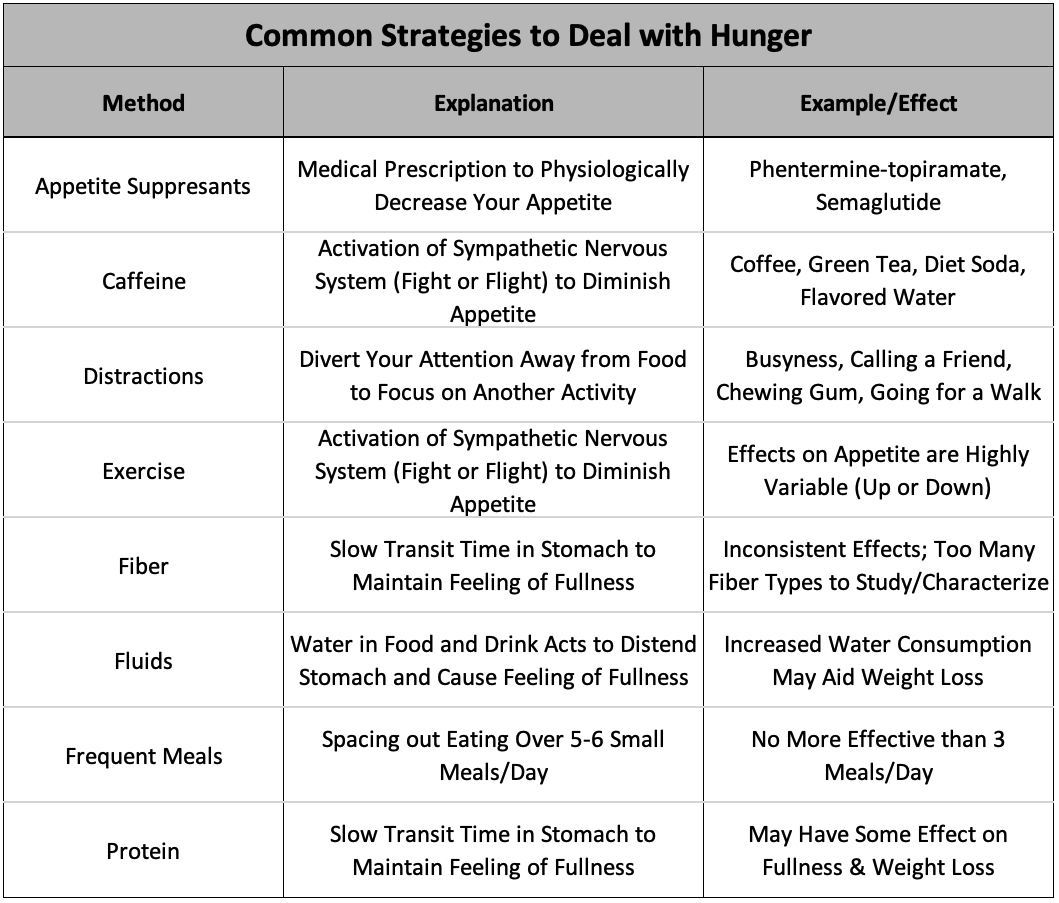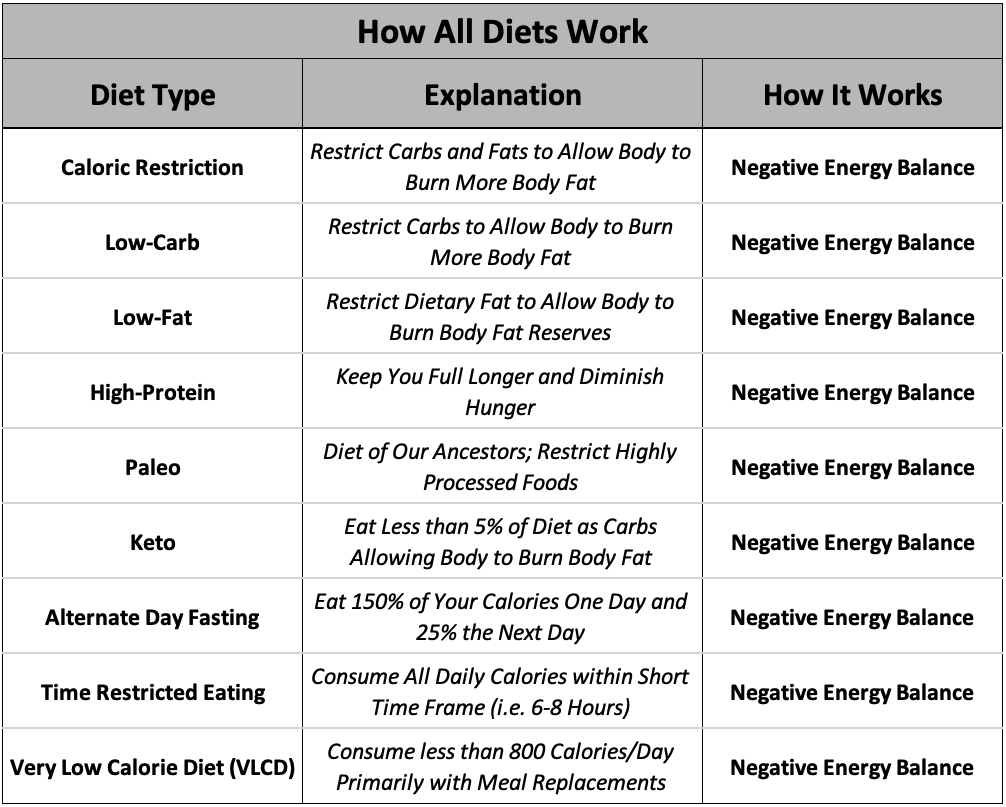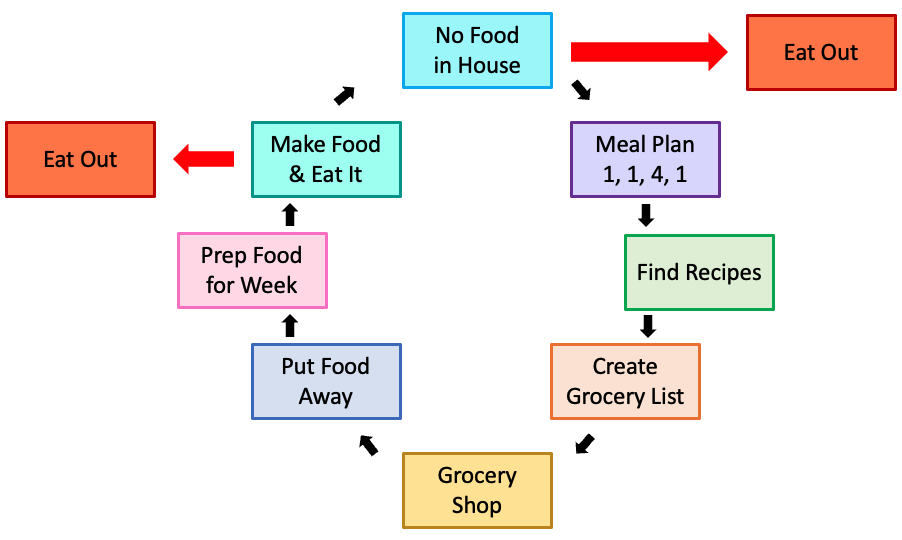How to Create a Weight Loss Diet You Can Stick To

In my last post, I made the case why dietary adherence, rather than diet type or meal timing, is the number one predictor of weight loss success. Here I would like to talk about the steps you can take to create a weight loss diet that you can stick to (how to increase dietary adherence).
- Take a Weight Loss Medication to Decrease Appetite: weight loss medications are a safe and effective tool for decreasing your appetite (drive to eat) and helping you lose weight. There are some nutrition and fitness purists who are medication holdouts but even traditional weight loss programs like Weight Watchers have been adopting medications.
Weight loss medications are more effective than diets to reduce hunger (i.e., low-carb, high-protein, Paleo, Keto). High protein/high fat diets may have some acute (short-term) effects on hunger but their failure to promote long-term weight loss prevents me from recommending them as a primary strategy for hunger control.
While it is an individual choice whether you take a weight loss medication, I personally, would. The risk/reward benefit seems worth it to me. There are some side effects, but I think you should try to use every tool at your disposal. Other commonly utilized strategies to control hunger during calorie restriction are listed in Table 1.

Table 1. Common Strategies to Deal with Hunger.
Of these, caffeine, distractions, fluids, and protein may be worth incorporating into your overall plan. Exercise has variable effects on hunger but is still a cornerstone of any good weight loss program. I wouldn’t waste any effort thinking about fiber or frequent meals.
The bottom line is the diet and exercise strategies for controlling hunger (Table 1) should serve as an adjunct to weight loss medications and not as a primary intervention/solution.
- Choose a Diet Type/Way of Eating: you must have some type of gameplan when it comes to eating. I am a fan of the low-calorie diet restricting fat and carbohydrate calories (but also get to eat fat and carbohydrate calories), but you can choose whatever you want (Table 2).

Table 2. Regardless of Their Methods, All Diets Work By Causing a Negative Energy Balance.
If you can tolerate it and are working with a doctor (i.e., your primary care physician) then you can go on a very low-calorie diet (VLCD). The level of restriction you choose will depend on your ability to tolerate discomfort, how much weight you have to lose/what your weight loss goals are, your job/work requirements (desk job versus manual labor), and your current exercise routine.
I am not a fan of fad diets (i.e., Atkins, Paleo, Keto, Intermittent Fasting, etc.) but if you can follow the steps that I outline below these diets can also work for you long-term. The primary problem with fad diets is that they claim to offer some “secret code” or “metabolic advantage”, when in fact, they do not. Their claims are a distraction from what really matters: a well thought out and relentlessly executed plan.
- Control Your Food Environment: humans are designed to seek out sugar, fat, and salt for survival and reproductive purposes (it gives us pleasure). The very same hardwiring that helped our ancestors survive and reproduce has been turned against us in our modern-day food environment. There are just too many tempting foods and too many opportunities to eat.
Many people will lament that they just do not have the willpower to resist tempting foods. But who does? Rather than relying on some “iron will” to resist tempting foods, make it a point to control your food environment (the foods you are exposed to/in your immediate vicinity) by limiting your access to these calorie rich foods while at the same time making lower calorie foods and snacks easy and convenient to access/eat. It may seem overly simplistic but if the food is not there, you cannot eat it.
Getting on a good weekly meal cycle (#7) is a great start to managing your meals, making sure you have snacks on hand, and limiting your indulgences. Create a list of all the snacks you like to eat and a separate list of indulgences and incorporate them into your meal plan. The number of snacks and indulgences you choose will differ depending on what stage of weight loss you are in (Table 3). This way you know ahead of time exactly where your calories are coming from for the week.

Table 3. An Example of a Plan for Managing Meals, Snacks, and Indulgences.
Finally, in addition to meal planning, to fully control your food environment, you may have to set some boundaries/nutrition rules (#8, below), reduce your portion sizes, limit the frequency that you eat that food, substitute it out (apple slices for chips) or go cold turkey. Controlling your food environment is one of “the” most important things you can do. There’s just no sense in playing with fire, eventually you’re going to get burned.
- Weigh Yourself At Least Once a Week: the best way to know if you are losing, maintaining, or gaining weight is the good old bathroom scale. The bathroom scale cannot tell you your body composition (lean tissue versus fat) but it will give you a general idea of whether you are trending in the right direction.
Your weight can fluctuate several pounds each day depending on water weight (fluids drank + sodium) but without weighing yourself you are totally in the dark and cannot make any corrections until it becomes far too late.
Some people may find it beneficial to weigh yourself daily. Combined with your food logs (#6), this will give you the opportunity to reduce the calories at your next meal or meals. Research has shown daily weighing and fine-tuning to be an effective weight loss tool, although I’m not sure this level of intensity can be maintained over the long run.
- Break Your Diet Up into Phases/Stages: you’re not going to go on a weight loss diet forever. You will need to develop distinct phases/stages to differentiate between weight loss and weight maintenance. You will also likely want to change your level of caloric restriction (i.e., 1000 calories/day versus 1600 calories/day) depending on the phase/stage of dieting. I would recommend 4–5-week intervals to correspond with the calendar.
Intermittent fasting (i.e., alternate day fasting, 5:2) and incorporating “cheat” days already kind of breaks up your diet into phases/stages. The problem is that “this” is your diet. There’s no (lesser) alternative and the phases are too short. Intermittent fasting is typically broken up into time blocks between two and seven days. I feel that it would be more beneficial to break your diet up into larger time blocks such as 4-5 weeks.
Breaking up your diet into time blocks allows you to “pace yourself” and to know where the finish line is. It will help you maintain the intensity required to get to the next diet phase/break. Diets without a defined stop and start turn into a muddled, low adherence mess. Now you’re dieting but you’re not dieting, restricting but not restricting, and putting forth effort without any reward (pleasure or weight loss).
- Start Food Logging to Understand Where Your Calories are Coming From: food logging (i.e., food diary, calorie counting) helps you build an awareness of the total number of calories you are consuming and the sources of those calories. To lose weight and keep it off you must have a general idea of what foods are high calorie (caution) and what foods are low calorie (green light).
Food logging allows you to modify/change the foods you eat and holds you accountable. So many of our calories are passively consumed (bag of chips, handful of nuts, extra serving of xyz) that we’re barely aware that we’re even eating them.
Food logging can be a real tedious pain in the butt; however, it will allow you to see if you are sliding into poor eating habits and to correct them before they become too engrained (see # 11 Managing Transitions).
- Get on a Weekly Meal Cycle: as soon as you have decided on a weight loss medication, picked a diet type, and planned out the next 12-16 weeks in dieting “blocks” it’s time to get started. Regardless of the diet type you have chosen, you will need to get on a weekly meal cycle.
Figure 1. The Weekly Meal Cycle.
Getting on and staying on a weekly meal cycle fits hand in glove with #3, Controlling Your Food Environment and are two of the most important things you can do to lose weight. Anything that breaks the weekly meal cycle (i.e., #11 Big Transitions) must be dealt with ASAP before you (unintentionally) slide into poor habits.
- Set Boundaries/Hard Nutrition Rules: you must develop your RED LINES of nutrition. There are things you are and are not willing to do, eat or drink. They can be steeped in nutrition facts or completely arbitrary, it’s up to you. Maybe you give up alcohol, soda, or potato chips. Maybe you only consume them on the weekends or a certain day of the week or in a portion-controlled manner.
Whatever you choose to do, be clear about them. Write out your rules and stick to them or modify them as necessary. There can’t be any ambiguity here. Ambiguity is a slippery slope inconducive to sustainable weight loss.
The ultimate goal is that your nutrition rules become so engrained that you don’t even need to think about them anymore. They’re just what you do.
- Develop Situational Preparedness/Back-Up Plans: things are not going to go as planned. This is one of the reasons meal plans don’t work. When something comes up (work dinner, working late, don’t have time to cook) what is your back-up plan? You will need to have a working knowledge of nutrition (#6 where calories come from in food) especially when eating out. If possible, look at the menu ahead of time. Have some “go to” low-calorie items when eating out. At home, make sure to have emergency/bridge meals (i.e. frozen salmon, scrambled eggs, tuna salad, cereal) on hand that you can throw together without breaking the calorie bank.
- Slowly Reincorporate Indulgences and Previously “Off Limits” Foods in a Controlled Fashion: dieting works because it reduces, restricts, or completely eliminates high calorie foods whether that be through decreasing your food frequency (how often you eat a food), your energy density (how many calories are packed into that food) or your portion (size of meal or snack).
One of the many reasons dieting doesn’t work in the long-term is that diets are too restrictive. It takes restriction for the diet to work. Not enough restriction = not much weight loss. But too much restriction over time = you feel deprived, fall off the wagon, and eventually don’t restrict at all.
Food logging (#6 above) will help you develop an awareness of where your calories are coming from. You can then more fully control the calories from your meals (i.e., fat and/or portions) and know the difference between a snack and an indulgence.
As I suggested in #3, Controlling Your Food Environment, I would list out on a piece of paper (or Excel document) your favorite snacks and your favorite indulgences. Then you can determine how many snacks and how many indulgences you can eat per day depending on what phase of dieting you are in. If you can’t control a particular indulgence (you eat the entire bag of chips) you may have to go cold turkey for that food.
- Manage Big Diet Transitions: diet transitions are (major) life events that break you out of your weekly meal cycle (#7 above) and change the way you eat. Examples of diet transitions are vacations, moving, pregnancy, job change, illness, and holidays, although there are many more.
There are two categories of dietary transitions. Hard transitions when you abruptly stop eating a certain way such as when you stop eating a meal replacement, very low-calorie diet and transition into eating “real food” OR soft transitions when you gradually slide into a new eating pattern almost without knowing it, frog in boiling water style.
Almost all diet transitions tend to be soft transitions. Fad diets entirely eliminating, or severely restricting fats, carbohydrates, snacks, and indulgences will not last forever (#5 above). Eventually you will slide (usually slide, not fall) off the wagon and slowly reincorporate these items back into your diet. Before you know it the diet you’re eating no longer resembles the fad diet you started. You’re back to square one.
Even if you’re not actively dieting, diet transitions (life changes) almost always lead to weight gain (seldom weight loss unless you are super stressed and you are one of the rare birds that have a coping mechanism to not eat, rather than eat). Diet transitions can be super emotionally charged such as a death in the family or as benign as your kid taking on more extracurricular activities. For a more complete list of diet transitions please click here.
Whatever the transition happens to be, it is of utmost importance that you learn to work/plan around it and get back on your weekly meal cycle as soon as possible.
- Make Weight Loss a Priority, Check-In, and Recommit: the first thing you need to do when it comes to a weight loss program is to make it a priority. Put it at the top of your list, go all in, and don’t let anything get in the way (no excuses mentality). This will get you started.
The motivation you have at the start of your journey will fade over the coming days and weeks. You need to constantly check in to monitor your progress by logging your food (#6) (daily) and weighing yourself (#4) (at least weekly). Your goal should be to win at every meal, win every day, win every week, and win every month. If you can stack one win on top of the other and have more wins than losses, you will lose weight.
If you find that your weight loss is stalling or even reversing, recommit. Try not to get discouraged and say screw it. Stalls and reversals are completely normal. They’re part of the process. You know what’s worked for you. You need to get back to that whether that means meal replacements, tv dinners or cutting back on carbs, snacks, or indulgences. If you are continuing to food log, you know what your problems are. If you stopped food logging, sorry, you’ve got to go back to doing it.
There’s no magic formula, food combination or diet for losing weight and keeping it off. But there are a number of things you can do to make it a little easier (#1-12 above). Gaining weight is so, so easy in our current food environment. I can go to visit my in-laws in Buffalo, New York for a week and easily gain 5-7 pounds. Losing weight is so, so hard. It will take me several months to lose that same 5-7 pounds. I used to be able to lose that weight in a couple of weeks but ahh, life man.
Dietary adherence diminishes over time. That’s just being human. You can’t expect to stay hyper focused on one thing for so long. Despite our best intentions we slide into poor eating habits over time. It’s not intentional. You more than likely don’t make the conscious decision to say – “I’m going to start eating poorly today”. In the moment you might say, “oh shit, I need something to eat and I need to do it quickly (I’ve got other stuff to do). I know I shouldn’t be eating this, but I’ll do better next time”.
I know the steps above take a lot of work but it takes a lot of work to develop a comprehensive, systematic, sustainable system for losing weight and keeping it off. I know no other way and until someone shows me, these are the steps you need to take to lose weight and keep it off, hopefully forever.






Responses